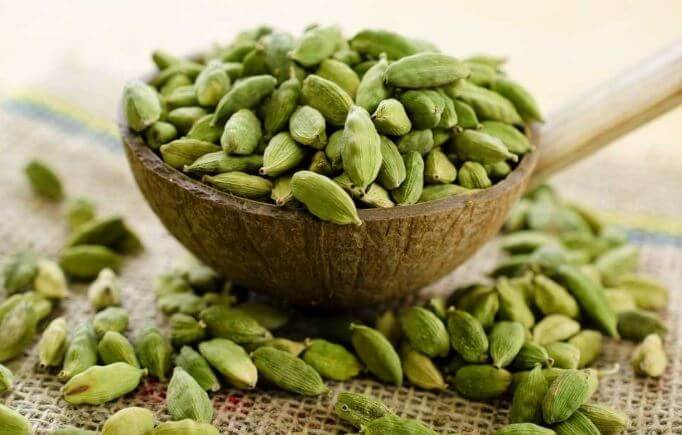Ela is pungent, aromatic, herbaceous and perennial plant in the ginger family. This plant grows in height about 2-4m. Leaves of this plant are 20-40cm long, linear-lanceolate, alternate in two ranks and have long pointed tip. Leaves are dark green and sword shaped.
Flowers are produced in loose spikes about 30-60cm long and white or pale violet in color. Flowers contain both male and female parts. Fruits are 1-2cm long three sided, three chambered, yellow green pods surrounding several black and brown seeds. The green seed pods of this plant are dried and seeds are used as spice for various Indian cuisines.
Habitat
Cardamom is commonly native to India. It is widely found in Western Ghats of southern India. This area is known as the cardamom hills. Tropical rain forests at the elevations of 2500-5000ft are best for its growth. By the 21st century Guatemala is largest producer of cardamom in world. Later it is introduced to other parts of tropical Asia and this plant is widely cultivated for its aromatic and medicinal properties of seeds. It is also found in other countries like Guatemala, Sri Lanka, New Guinea and Tanzania. It is also grown in Nepal, Vietnam, Thailand and North America.
Classification
Vernacular Names
- Latin - Elettaria cardamomum
- Hindi– Chotti ellachi
- English– Lesser cardamom, King of spice
- Kannada– Elakki
- Malayalam– Elam
- Telugu– China elakulu, Yelakkapalu
- Tamil– Yelakka
- Marathi– Velachi, Veldode
- Gujarati– Elachi, Chot elach
- Arabic– Kakul
- Farsi– Heelabak, Ilaichi khurd
Ayurvedic Properties
|
Hindi / Sanskrit
|
English
|
|
Rasa
|
Katu, Madhur
|
Taste
|
Pungent, Sweet
|
|
Guna
|
Laghu, Ruksha
|
Physical Property
|
Light, Dry
|
|
Virya
|
Sheet
|
Potency
|
Cold
|
|
Vipaka
|
Katu
|
Metabolic Property (After Digestion)
|
Pungent
|
Effects on Doshas
It pacifies kapha and pitta dosha.
|
Charak Samhita
|
Sushrut Samhita
|
Vagbhata
|
Bhavprakash
|
- Shwashara – Herbs used in breathlessness, asthma, dyspnea.
- Angamarda Prashmana – Herbs used in body aches.
- Katuka Saknda – Herbs bitter in taste.
- Shirovirechnopaga – Herbs used in nasya treatment.
|
Eladi gana
|
Eladi, Trijatka, Charurjatka
|
Shwashara
|
Practical uses of Elettaria cardamomum
- Cardamom is used to cure indigestion, nausea, vomiting and used to expel out phlegm out of body. It is very beneficial in congestion of lungs and other pulmonary diseases.
- It is also used as laxative and used to prevent stomach pain, flatulence and gripping.
- Seed oil is very good for digestive system. It is used to relieve colic, to give warmth to stomach and it works wonderfully in heart burn.
- Raw seeds of cardamom are chewed to detoxify caffeine and bad breath of mouth. Seeds are also used as cooking spice and to flavor various medicines.
- It is used as appetizer and this herb is also very effective in dyspepsia.
- It is used in throat related troubles, inflammation of eye lid and it is extensively used to treat infections associated with tooth and gums.
- This herb is also beneficial for the sufferers of kidney stones.
- It is analgesic and best used in the treatment of arthritis, sore muscles and lower back pain.
- It is antifungal, antibacterial and antiviral in nature and it is used against various infections.
- It is also used to reduce the inflammation and is also beneficial in diarrhea.
- Seeds boiled in water to prepare tea is used to control depression.
- Cardamom seed powder mixed with amla juice acts as diuretic and is very effective in cystitis, gonorrhea and scanty urination.
- Cardamom seeds are useful for relieving sexual dysfunctions. These are used in impotence and premature ejaculation.
- Seeds with mint leaves are very beneficial for hiccups.
- It is used to pacify vata and kapha dosha.
Cautions
- Cardamom should not be given during pregnancy.
- It is not advisable for gall stone sufferers.
- Oil is not advised to people with sensitive skin.
Parts used
Dosage
- Seed powder – 0.5 to 1gm
- Seed oil – 2-5 drops



